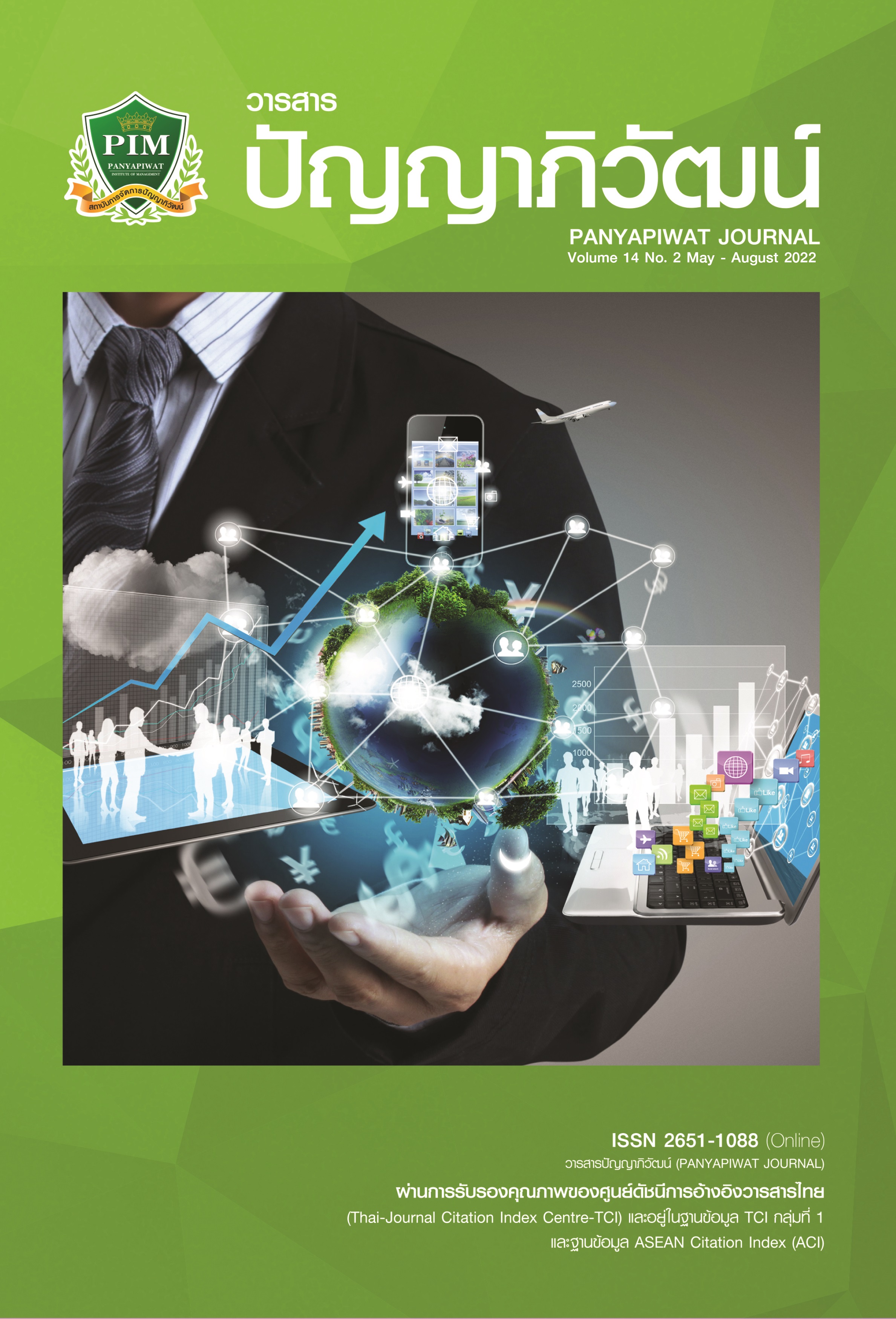การคัดเลือกและการจัดลำดับความสำคัญของปัจจัยเสี่ยงบนห่วงโซ่อุปทานในอุตสาหกรรมปลาทูน่าประเทศไทยภายใต้สภาพแวดล้อมที่คลุมเครือ
Main Article Content
บทคัดย่อ
การวิจัยครั้งนี้มีวัตถุประสงค์ 1) เพื่อคัดเลือกปัจจัยเสี่ยงบนห่วงโซ่อุปทานในอุตสาหกรรมปลาทูน่าประเทศไทย 2) เพื่อจัดลำดับความสำคัญของปัจจัยเสี่ยงบนห่วงโซ่อุปทานในอุตสาหกรรมปลาทูน่าประเทศไทย โดยกรอบแนวคิดประกอบด้วย 3 ขั้นตอน ขั้นตอนแรก สำรวจปัจจัยเสี่ยงผ่านการทบทวนวรรณกรรมอย่างละเอียด ทำให้ค้นพบปัจจัยเสี่ยงทั้งหมด 20 ประการในห่วงโซ่อุปทาน ขั้นตอนที่สอง การนำเทคนิค Fuzzy Delphi มาใช้เพื่อเลือกปัจจัยเสี่ยงที่เกี่ยวข้องกับอุตสาหกรรมปลาทูน่าของประเทศไทย ขั้นตอนที่สาม การวิเคราะห์อัตราส่วนการประเมินนํ้าหนักอย่างเป็นขั้นตอนหรือที่เรียกว่า A Step Wise Weight Assessment Ratio Analysis (SWARA) เพื่อใช้จัดลำดับความสำคัญของปัจจัยเสี่ยงที่เกี่ยวข้องอย่างชัดเจน
ผลการวิจัยชี้ให้เห็นว่า มีปัจจัยเสี่ยงทั้งหมด 12 ปัจจัยที่เกี่ยวข้องกับอุตสาหกรรมปลาทูน่าของประเทศไทยและการศึกษาครั้งนี้พบว่า ปัจจัยความเสี่ยงสูงตามลำดับค่านํ้าหนักปัจจัยเสี่ยง ได้แก่ ความเสี่ยงด้านอุปทาน ความเสี่ยงด้านกฎหมายและกฎระเบียบ ความเสี่ยงของการเปลี่ยนแปลงรสนิยมและความชอบของลูกค้า ความเสี่ยงด้านนวัตกรรม ความเสี่ยงจากความผันผวนของราคา ความเสี่ยงด้านอุปสงค์ และความเสี่ยงด้านความล้มเหลวในการสื่อสารกับซัพพลายเออร์และการล้มละลายของซัพพลายเออร์ ซึ่งผลลัพธ์เหล่านี้สามารถช่วยให้ผู้จัดการห่วงโซ่อุปทาน เริ่มต้นกลยุทธ์การลดความเสี่ยงในเชิงรุกได้อย่างเป็นขั้นตอน
Article Details

อนุญาตภายใต้เงื่อนไข Creative Commons Attribution-NonCommercial-NoDerivatives 4.0 International License.
“ข้าพเจ้าและผู้เขียนร่วม (ถ้ามี) ขอรับรองว่า บทความที่เสนอมานี้ยังไม่เคยได้รับการตีพิมพ์และไม่ได้อยู่ระหว่างกระบวนการพิจารณาลงตีพิมพ์ในวารสารหรือแหล่งเผยแพร่อื่นใด ข้าพเจ้าและผู้เขียนร่วมยอมรับหลักเกณฑ์การพิจารณาต้นฉบับ ทั้งยินยอมให้กองบรรณาธิการมีสิทธิ์พิจารณาและตรวจแก้ต้นฉบับได้ตามที่เห็นสมควร พร้อมนี้ขอมอบลิขสิทธิ์บทความที่ได้รับการตีพิมพ์ให้แก่สถาบันการจัดการปัญญาภิวัฒน์หากมีการฟ้องร้องเรื่องการละเมิดลิขสิทธิ์เกี่ยวกับภาพ กราฟ ข้อความส่วนใดส่วนหนึ่งและ/หรือข้อคิดเห็นที่ปรากฏในบทความข้าพเจ้าและผู้เขียนร่วมยินยอมรับผิดชอบแต่เพียงฝ่ายเดียว”
เอกสารอ้างอิง
Ali, S. M., & Nakade, K. (2018). Optimal ordering policies in a multi-sourcing supply chain with supply and demand disruptions-A CVAR approach. International Journal of Logistics Systems and Management, 28(2), 180-199.
Ali, S. M, Moktadir, M. A., Kabir, G., Chakma, J., Rumi, M. J. U., & Islam, M. T. (2019). Framework for evaluating risks in food supply chain implications in food wastage reduction. Journal of Cleaner Production, 228, 786-800.
Bouzon, M., Govindan, K., Rodriguez, C. M. T., & Campos, L. M. S. (2016). Identification and analysis of reverse logistics barriers using fuzzy delphi method and AHP. Resource Conserve Recycle, 108, 182-197.
Chen, S. J., & Hwang, C. L. (1992). Fuzzy multiple attribute decision making methods. Springer-Verlag Berlin Heidelberg.
Eghbali-Zarch, M., Tavakkoli-Moghaddam, R., Esfahanian, F., Sepehri, M. M., & Azaron, A. (2018). Pharmacological therapy selection of type 2 diabetes based on the SWARA and modified multimoora methods under a fuzzy environment. Artificial Intelligence in Medicine, 87, 20-33
Fan, H., Li, G., Sun, H., & Cheng, T. C. E. (2017). An information processing perspective on supply chain risk management antecedent’s mechanism and consequences. International Journal of Production Economics, 185, 63-75.
FAO. (2020). GLOBEFISH-information and analysis on world fish trade: Canned tuna demand rising amid COVID-19 pandemic. http://www.fao.org/in-action/globefish/market-reports/resource-detail/en/c/1306841/
Gokarn, S., & Kuthambalayan, T. S. (2017). Analysis chain of challenges inhibiting the reduction of waste in food supply. Journal of Cleaner Production, 168, 595-604.
Ho, W., Zheng, T., Yildiz, H., & Talluri, S. (2015). Supply chain risk management a literature review. International Journal of Production Research, 53(16), 5031-5069.
Kersuliene, V., Zavadskas, E. K., & Turskis, Z. (2010). Selection of rational dispute resolution method by applying new Step-wise Weight Assessment Ratio Analysis (SWARA). Journal of Business Economics and Management, 11(2), 243-258.
Kirilmaz, O., & Erol, S. (2017). A proactive approach to supply chain risk management: Shifting orders among suppliers to mitigate the supply side risks. Journal of Purchasing and Supply Management, 23, 54-65. https://doi.org/10.1016/j.pursup.2016.04.002
Kuo, Y. F., & Chen, P. C. (2008). Constructing performance appraisal indicators for mobility of the service industries using fuzzy delphi method. Expert Systems with Applications, 35(4), 1930-1939.
Mangla, S. K., Luthra, S., Rich, N., Kumar, D., Rana, N. P., & Dwivedi, Y. K. (2018). Enablers to implement sustainable initiatives in agri-food supply chains. International Journal of Production Economics, 203(C), 379-393.
Moazzam, M., Akhtar, P., Garnevska, E., & Marr, N. E. (2018). Measuring agri-food supply chain performance and risk through a new analytical framework: A case study of New Zealand dairy. Journal of Production Planning and Control, 29, 1258-1274.
Murry, J. W. Jr., & Hammons, J. O. (1995). Delphi a versatile methodology for conducting qualitative research. The Review of Higher Education Johns Hopkins University Press, 18(4), 423-436.
Nakhaei, J., Lale Arefi, S., Bitarafan, M., & Kaplin´ski, O. (2016). Model for rapid assessment of vulnerability of office buildings to blast using SWARA and SMART methods: A case study of swiss RE tower. Journal of Civil Engineering and Management, 22(6), 831-843.
Okoli, C., & Pawlowski, S. D. (2004). The delphi method as a research tool an example design considerations and applications. Information & Management, 42(1), 15-29.
Olechowski, A., Oehmen, J., Seering, W., & Ben-Daya, M. (2016). The professionalization of risk management what role can the ISO 31000 risk management principles play. International Journal of Project Management, 34(8), 1568-1578.
Popovic, G., Stanujkic, D., Brzakovic, M., & Karabasevic, D. A. (2019). Multiple-criteria decision-making model for the selection of a hotel location. Land Use Policy, 84, 49-58.
Robbins, R. C., Mcmanus, R. P., Mitchell, R. S., Latter, D. R., Moon, M. R., Olinger, G. N., & Miller, D. C. (1993). Management of patients with intramural hematoma of the thoracic aorta. Circulation, 88, 1-10.
Rostamzadeh, R., Keshavarz-Ghorabaee, M., Govindan, K., Esmaeili A., & Bodaghi Khajeh Nobar, H. (2017). Evaluation of sustainable supply chain risk management using an integrated fuzzy TOPSIS-CRITIC approach. Journal of Cleaner Production, 175, 651-669.
Sharma, Y. K., Yadav, A. K., Mangla, S. K., & Patil, P. P. (2018). Ranking the success factors to improve safety and security in sustainable food supply chain management using fuzzy AHP. Articles of Material Todays: Proceeding, 5(5), 12187-12196.
Shen, Y. C., Lin, G. T. R., & Tzeng, G. H. (2011). Combined DEMATEL techniques with novel MCDM for the organic light emitting diode technology selection. Expert Systems with Applications, 38, 1468-1481.
Sreedevi, R., & Saranga, H. (2017). Uncertainty and supply chain risk: The moderating role of supply chain flexibility in risk mitigation. International Journal of Production Economics, 193, 332-342.
Tran, N., Rodriguez, U. P., Chan, C. Y, Phillips, M. J., Mohan, C. V., Henriksson, P. J. G., Koeshen- Drajana, S., Suri, S., & Hall, S. (2017). Indonesian aquaculture futures: An analysis of fish supply and demand in Indonesia to 2030 and role of aquaculture using the Asia fish model. Marine Policy, 79, 25-32.
Wang, X. (2016). Food supply chain safety risk evaluation based on AHP fuzzy integrated evaluation method. International Journal of Security and Its Applications, 10(3), 233-244.
Zarbakhshnia, N., Soleimani, H., & Ghaderi, H. (2018). Sustainable third-party reverse logistics provider evaluation and selection using fuzzy SWARA and developed fuzzy COPRAS in the presence of risk criteria. Applied Soft Computing, 65, 307-319.


